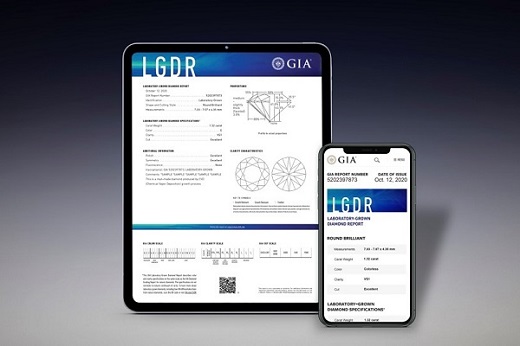GIA Now Giving Details of Lab-Grown Treatments
 RAPAPORT... The Gemological Institute of America (GIA) has started providing specific information on post-growth treatments for synthetic diamonds, marking the latest shift in its approach to the category.The institute's Laboratory-Grown Diamond Reports now say if there is evidence of a treatment to change the color of a stone, or if there is no evidence, a GIA spokesperson told Rapaport News Monday. Some stones carry the comment: "Whether this man-made diamond has been treated is currently undeterminable."Previously, all reports included a generic statement that the lab-grown diamond "may" have been treated. The changes went into effect in early March. The reports will continue to state the growth type: chemical vapor deposition (CVD) or High Pressure-High Temperature (HPHT). The move comes amid discussions in the industry over whether "as-grown" diamonds - a marketing term used in the synthetics sector - should attract a premium. Color treatments are common in CVD material, as many crystals emerge from synthesis machines with a brown tinge."We made this change in response to feedback from our clients - manufacturers, retailers and brands - that there is interest in knowing about post-growth color treatments for laboratory-grown diamonds," the GIA spokesperson commented.Speaking to the Rapaport Diamond Podcast in September, GIA CEO Susan Jacques said the organization "didn't feel that it was essential for consumers to know [if a lab-grown diamond] has or has not been treated," as "consumers are not that granular in the expectation of what they're learning." However, she added that the GIA would provide a letter stating whether it had detected a treatment, where necessary.Since then, the International Gemological Institute (IGI), one of the major players in the lab-grown space, has added specific treatment details to its lab-grown reports.The GIA introduced its Laboratory-Grown Diamond Reports, or LGDRs, in October. Importantly, the documents provide the same specific color and clarity grades that the organization offers for natural diamonds - the first time it had done this. Its previous synthetics reports used descriptive terms such as "near colorless" and "very slightly included.""If you look through that whole journey until [the GIA] launched the LGDR, you clearly see a pattern of...evolving transparency regarding the grading of lab-grown diamonds," said Leon Peres, CEO of Green Rocks, a producer and supplier of untreated synthetic diamonds and part of Ofer Mizrahi Diamonds.Image: A GIA lab-grown report. (GIA)
RAPAPORT... The Gemological Institute of America (GIA) has started providing specific information on post-growth treatments for synthetic diamonds, marking the latest shift in its approach to the category.The institute's Laboratory-Grown Diamond Reports now say if there is evidence of a treatment to change the color of a stone, or if there is no evidence, a GIA spokesperson told Rapaport News Monday. Some stones carry the comment: "Whether this man-made diamond has been treated is currently undeterminable."Previously, all reports included a generic statement that the lab-grown diamond "may" have been treated. The changes went into effect in early March. The reports will continue to state the growth type: chemical vapor deposition (CVD) or High Pressure-High Temperature (HPHT). The move comes amid discussions in the industry over whether "as-grown" diamonds - a marketing term used in the synthetics sector - should attract a premium. Color treatments are common in CVD material, as many crystals emerge from synthesis machines with a brown tinge."We made this change in response to feedback from our clients - manufacturers, retailers and brands - that there is interest in knowing about post-growth color treatments for laboratory-grown diamonds," the GIA spokesperson commented.Speaking to the Rapaport Diamond Podcast in September, GIA CEO Susan Jacques said the organization "didn't feel that it was essential for consumers to know [if a lab-grown diamond] has or has not been treated," as "consumers are not that granular in the expectation of what they're learning." However, she added that the GIA would provide a letter stating whether it had detected a treatment, where necessary.Since then, the International Gemological Institute (IGI), one of the major players in the lab-grown space, has added specific treatment details to its lab-grown reports.The GIA introduced its Laboratory-Grown Diamond Reports, or LGDRs, in October. Importantly, the documents provide the same specific color and clarity grades that the organization offers for natural diamonds - the first time it had done this. Its previous synthetics reports used descriptive terms such as "near colorless" and "very slightly included.""If you look through that whole journey until [the GIA] launched the LGDR, you clearly see a pattern of...evolving transparency regarding the grading of lab-grown diamonds," said Leon Peres, CEO of Green Rocks, a producer and supplier of untreated synthetic diamonds and part of Ofer Mizrahi Diamonds.Image: A GIA lab-grown report. (GIA)